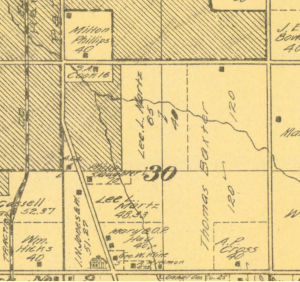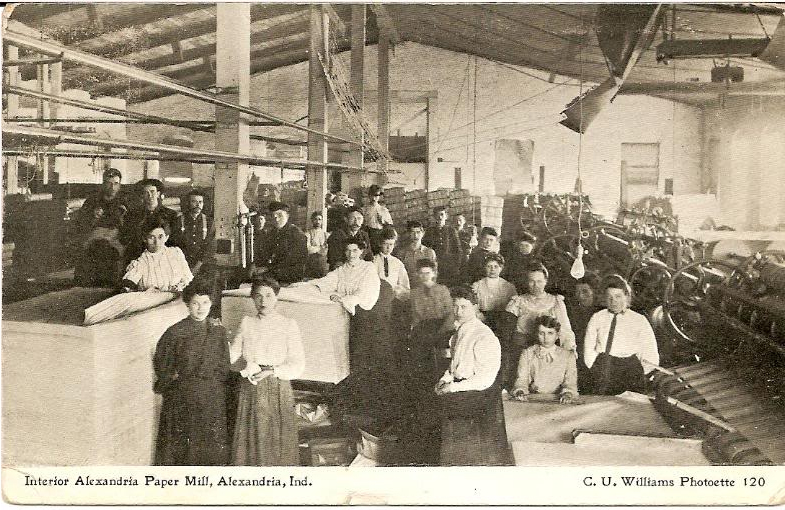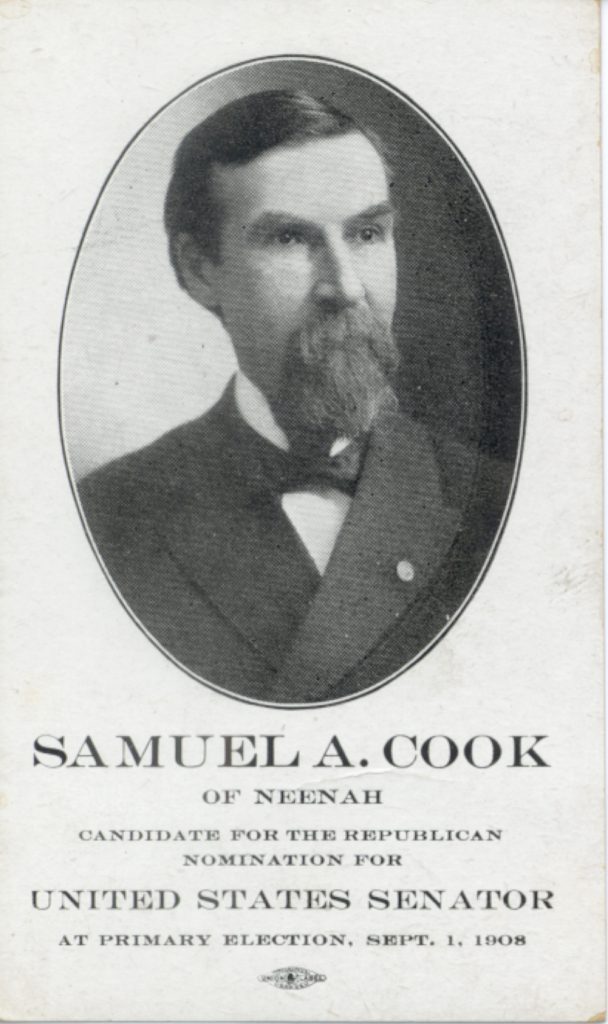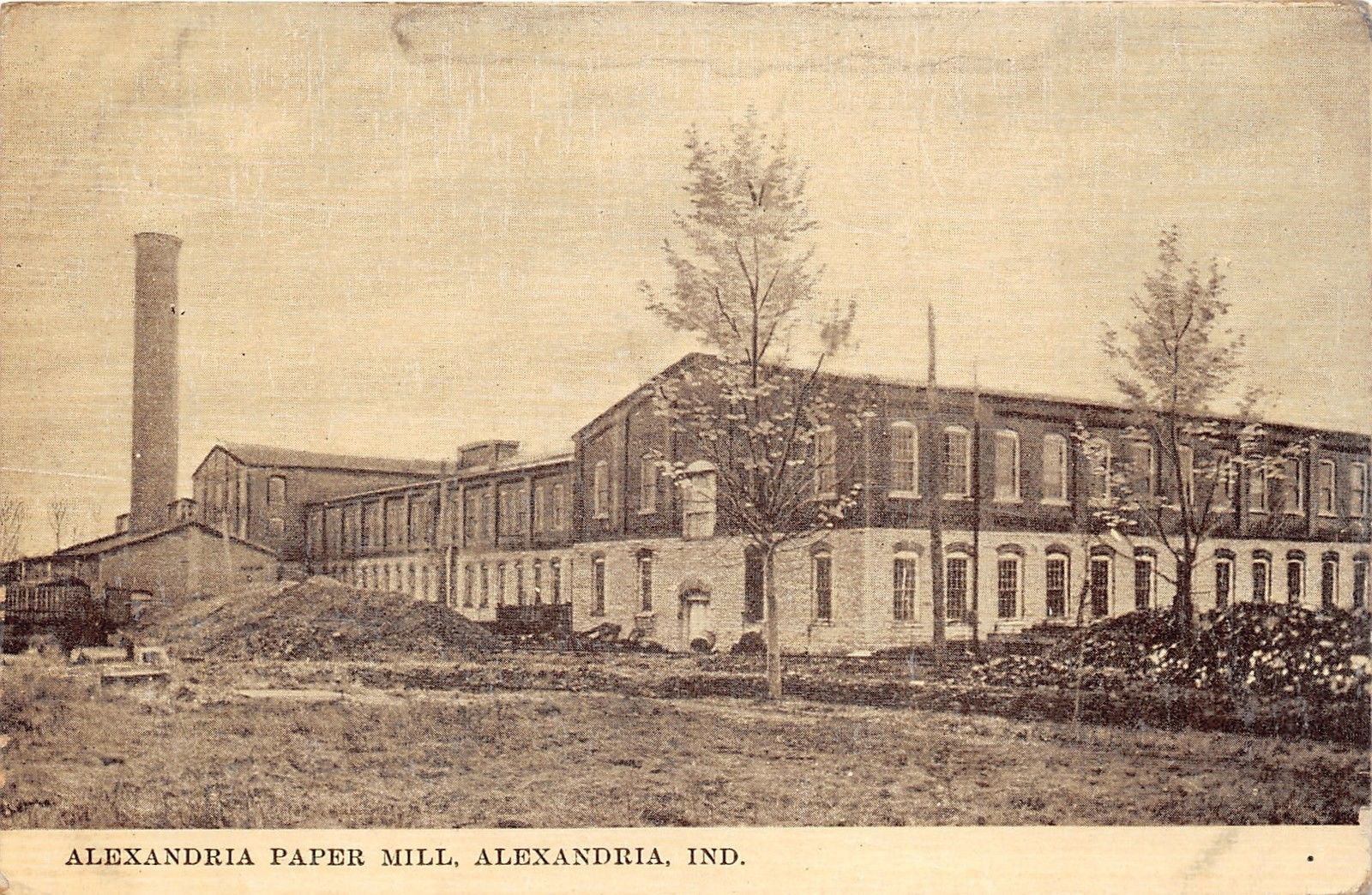Setting the Stage
It is a testament to S.A. Cook’s management skills that the Alexandria Paper Mill was so quickly and efficiently designed and built from the ground up. He had an overall vision for this 30-acre parcel of land. Today we would call it a campus. His placement of the mill on the southern border of the property, the brick office nearby, and Pipe Creek running through the northern border, parallel with the factory. Located near the railroad line, side tracks were laid at company expense to afford easy access for deliveries of raw materials, and pick-up of the finished product. [1] [2]
While S.A. chose Alexandria for the inexpensive gas running through the county, he was not fully trusting that this would be a lasting source of energy to power the mill. The Daily Northwestern reported: “While the company feels very confident of an ample supply of gas for many years, in erecting its plant it has made provisions for the use of oil for fuel if necessary, and for the use of coal if that should at any time become desirable.” [3]
Following the dissolution of the partnership with M. H. Ballou in the spring of 1900, S.A. had a plan for the future. Since the formation of the S.A. Cook Manufacturing Company in 1897, he had been grooming Watson “Watt” Yule, and his son Harry Cook, to take management positions in the paper-making industry. At age 51, S.A. had no intention of moving to Alexandria to oversee the mill. 30-year-old Watt was working as a teller at the First National bank in Neenah, [4] and S.A. felt that he was experienced enough to take on a management role at Alexandria, and so positioned him as Secretary. At 19, Harry was finishing his formal education at the state university while continuing to learn the family business under the tutelage of his father. S.A. would send him to Alexandria in 1901.
In February 1899 the news arrived from Texas that John “Jack” Yule’s wife had passed away shortly after giving birth to their son. Knowing that he would not want to be so far away from family, S.A. offered him the role of company sales manager. In accepting the position, Jack moved to Alexandria.
The Yule brothers found places to lodge a short distance from the mill and began serving as the eyes and ears for their “uncle” S.A. Cook. Their relationship with S.A. has been documented in many places as uncle/nephew. While not technically correct, they were of the same generation as S.A.’s children, and trying to explain the correct relationship, which is first cousin-once-removed, was complicated, so they came to be known as his nephews.
Watt and Jack’s younger brother, Edwin Watson “Ed” Yule soon joined them in Alexandria. We know he was in Alexandria in 1901 when he married a girl from “home” in Canada, Georgina Louise Lemon, on July 17, 1901. He was 27, and she was 26, and they set up residence in a house that stood near the paper mill. [5] I can only imagine the enthusiasm with which the Yule brothers and Harry Cook welcomed Ed and Georgina on their arrival in Alexandria. Their marriage and subsequent residency in a home on the “South Side” of town created a home base for the family.
A married couple could provide the role of chaperone when they wished to entertain friends and family, such as the Tuesday evening party held on June 10, 1902 in honor of Miss E. M. Daville of Aurora, Canada, and Harry’s sister, Maud Cook. [6] More elaborate parties, such as the one given by Watt, on another Tuesday evening, March 2, 1905, required an additional chaperone, this time Mrs. F. P. Nourse filled the role. On that evening “guests were first driven to the paper mill and after going over the plant repaired to the home…which was situated nearby. Games and music were indulged in until a late hour. Elegant refreshments were served in four courses.” Harry Cook attended, his presence rounding out the numbers to eight couples. [7]
R. L. Polk was in town in 1901 to document the city of Anderson for a 1902-1903 City Directory, including the landowners and taxpayers of Madison County. The county directory noted the landowner’s name and post office address, acreage, and assessed value of real and personal property. S.A.’s property was included, showing a value of $1,310 for his 16-acre plot in Alexandria. [8]
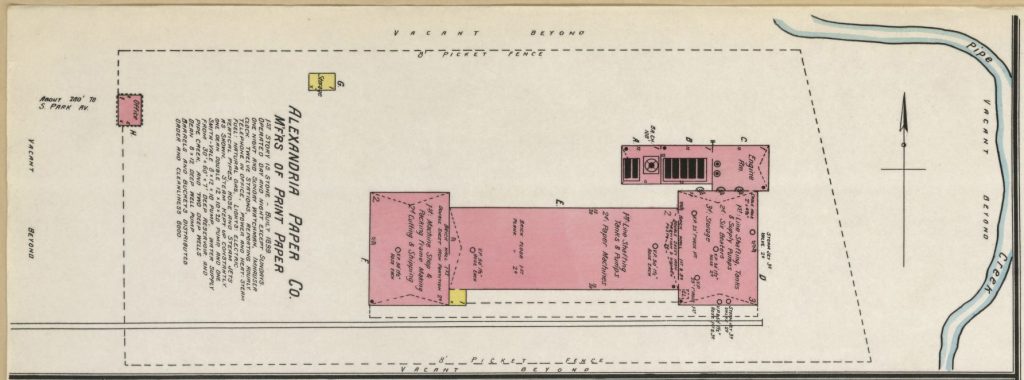
In March 1902 the Sanborn Fire Insurance Company was in Alexandria to map its important buildings. Sanborn Maps are wonderfully detailed, with facts about the community such as the size of the fire department, which streets are paved with brick, and how in 1902 there were four night police, and the lights were electric. The paper mill was included on page nine. In addition to detail about the construction of the mill, the map shows that whole property was surrounded by an 8’ white picket fence, a brick one-story office sat within the fence “about 280’ to S. Park Av.” The mill was mapped again in 1909 and a frame “Auto Shed” with storage shed attached, had been added. [9] [10]
The next Yule to marry was Jack. He married an Alexandria girl, Grace Jane Crouse on May 15, 1903 and they settled into the city of Alexandria. Four children were born to the couple: John Hawkins, George Edwin, Mary Elizabeth, John (Jack, Jr.) and Watson Albert. Only two, George and Mary Elizabeth, lived to adulthood. Jack resigned his position as company sales manager in February 1917, returning to Canada, settling in Renfrew, Ontario. He remained in the paper industry, working for the Kenwood Mills Limited of Albany, New York. He passed away on December 5, 1943 in Arnprior, at the age of 71. [11]
By January 1904 the availability of natural gas had dwindled to the point that the Paper Company was compelled to convert its plant to the use of coal. [12] The company was prepared for this change, and the transition from gas to coal was a smooth one. Meanwhile, many other companies began to close or leave Alexandria, which left many of the tenant houses empty. S.A. as president of the Rolling Mill Land Company, began to purchase these homes in 1906 for the purpose of converting the land back to farming. [13]The company reported that they would sell some homes to the county, place tenants in some and others would be torn down and removed. [14]
Watt Yule married 35-year-old Emly Ada Perryman [15] on 31 Dec 1907 in Toronto, Ontario, he was 37 years old. Until that time he had lived in what was known as the “Bachelor’s Retreat” located at 216 East John Street. In 1906 the boarding house was “facetiously called the ‘Orphans’ Asylum,’ for there are no two people of the same name residing there; every one of the ten members is marriageable, and all are perfectly willing that Landlady ‘Aunt’ Kate Williams, be called ‘mother,’ and, indeed, a mother she is, to the oddly made up family.”
“While to the un-poetic and unsentimental it is just a commonplace boarding house, to this family it is far more—it is home.” The article states that some of the residents have “passed by one year, the three score and ten marks.” Kate Williams who was interviewed for the article stated that “‘Happy Hooligan,’ as Watt Yule is deservedly called, …another of the happy family, which owes to him much of its happiness, for he is a natural clown, and though out on the road much of the time, he puts the house in good humor that lasts from one week’s end to his arrival at the other.” [16] I am not sure when Watson left the employ of the Alexandria Paper Mill, but he too remained working in the paper industry. For most of his later life, he lived in Chicago and was traveling for work to Green Bay, Brown Co., Wisconsin when he died of a heart attack on 17 Jan 1935 at the age of 64. [17]
S.A.’s daughter, Maud Christie Cook, graduated in 1897 at age 19 from Mt. Vernon Seminary, a private women’s college in Washington, DC., now known as the Mount Vernon Campus of The George Washington University. Following graduation, she returned to Wisconsin, and settled into acting as hostess for her father, supported by her aunts, Emeline and Margaret, and adopted aunt, Elizabeth Bartlett.
On November 21, 1913, S.A. announced the engagement of his daughter, Maud, to Charles F. Lancaster of Boston, Massachusetts. [18] The Fond du Lac newspaper describes the relationship between 35-year-old Maud and her 64-year-old father this way: “Miss Cook is a woman of rare attainments and very unusual executive ability. For some years she has been virtually business manager for her father, caring for a great mass of details in his affairs, and saving him untold work and worry. Her marriage and the probable separation it will entail will mean to Mr. Cook not only parting with his daughter, but with a business partner and chum as well.”
Her new husband, Mr. Lancaster, had long been engaged in real estate in Boston. At the time of his marriage to Maud, he was 46 years old. A divorcee, he had one son, Earle Winship Lancaster, born in 1897. Charles and Maud were married on Christmas Day, the “ceremony, which was performed at the residence of the bride’s father, on North Commercial Street, was marked by the utmost simplicity. Rev. E. H. Smith of the First Congregational church, Oshkosh, officiated. The bride wore white Venetian white point lace and was unattended. Although no invitations were issued, Mr. and Mrs. Lancaster received many beautiful presents.” [19]
After their marriage, the couple traveled extensively both here and abroad and were often guests at the home of Edwin and his wife in the house near the paper mill.
Dare I say that Henry Harold Cook, known as Harry, was a bit of a playboy who enjoyed parties and social gatherings, attending ball games, and driving fast cars. As the son of a wealthy man, he was afforded such luxuries and had the time and money to indulge in entertainment.
He is recorded as joining and being part of the organization of many new clubs in Alexandria such as the Alexandria Whist Club, the New Century Club, and the Fortnightly Club. In May 1909, at age 28, he became president of the Monroe Township branch of the Law and Order League. The league was formed to work for the retention of the saloons in Madison County in the coming “county option campaign.” The “purpose of the organization is not only to prevent the county from going dry, but to continue as a permanent thing, to force the saloonists to obey the law, and to drive out of business those saloonists who do not obey the law.” [20] I do not know if they were successful.
S.A. entered the political arena for the last time in 1907 when petitions were signed encouraging him to run for the Republican nomination for U.S. Senator against Senator Robert M. La Follette. He was defeated in the 1910 primary. His response to his loss was that he needed no sympathy, and that “I shall be found in the future as in the past, supporting those principles which I believe will benefit the whole people, helping rather than criticizing, and conscious that if the future may justly be judged by the past, my course shall in the end be fully vindicated.” [21]
As a young man in Alexandria, Harry kept rooms in town, first at the Bachelor’s Retreat, and later in an apartment in the Day Block, [22] but his permanent residence was with Edwin and Georgina Yule. It was here that at age 28, he was enumerated in the 1910 United States Federal Census, residing as a lodger. Edwin, 36 years old, was head of the household, with his wife, Georgina, age 35, keeping house. Also living with them was a servant, 19-year-old Lottie Stewart. [23]
The Paper Mill continued to grow and thrive under the leadership of the Yule brothers, Harry Cook and long-time superintendent William H. Brannon, [24] but it was the vision of S.A. that created the culture of the mill. In 1908 the city placed the tax value of the Paper Mill at $33,540. [25]
On April 5, 1902, S.A. had written a letter “To Our Employees.” In this letter, he informed the employees that he intended to adopt what he called “a short hour schedule,” in which the mill would “commence the manufacture and finishing of paper at seven o’clock Monday morning and stop manufacture and finishing of paper Saturday night at six o’clock, until further notice, wages to remain the same…” “And as a further consideration of your past, present and expected willingness to do, we have decided that each person in our employ for one year beginning April 1st, 1902, or those who may come later and remain continuously in our employ for one year, shall at the end of such year of service receive ten per cent on the amount paid such person during said year on present rate of wages. This may be construed by you as a share in the earnings of the business, or as interest on your wages, which is a workingman’s capital.” [26]
The culture that S. A. created for the mill was not only ahead of its time, but one that would withstand the test of time.
SOURCES:
- “Nearly Completed.,” (Neenah) Neenah Daily Times, 24 Oct 1899, p. 4, col. 4. Cit. Date: 10 May 2016.
- In 1998 the location of the railway lines was described this way: “There was a switch track east of Ind. 9 between Gaither Family Resources and the old Colonade or Elder House today. The track continued across the highway, through the Yule Estates area and connected with the present railroad track. The street car track came down the center of Harrison Street and through the present Yule Estates.” Club Notes. Alexandria-Monroe Historical Society,” The Times-Tribune, 25 Mar 1998, Wednesday, p. 12 & 13, col. 2 & 5; digital images, Newspapers.com (www.newspapers.com : accessed 10 Jun 2016).
- “Neenah Capital In Indiana,” The Oshkosh Daily Northwestern, 25 Jan 1900, Thursday, p. 6, col. 2; digital images, Newspapers.com (www.newspapers.com : accessed 26 May 2016).
- “Watson A. Yule Died Thursday,” The Menasha Record, 18 Jan 1935, Friday, p. 1, col. 5; digital images, Newspapers.com (www.newspapers.com : accessed 27 Aug 2021).
- John La Rue Forkner, History of Madison County, Indiana: A Narrative Account of Its Historical Progress, its People and Its Principal Interests, 2 volumes (Chicago and New York: Lewis Publishing Company, 1914), 2: 598-599. Cit. Date: 4 May 2016.
- “Alexandria, Ind.,” The Muncie Morning Star, 15 Jun 1902, Sunday, p. 8, col. 4; digital images, Newspapers.com (www.newspapers.com : accessed 28 Aug 2021).
- “Pleasantly Entertained,” The Times-Tribune, 2 Mar 1905, Thursday, p. front page, col. 2; digital images, Newspapers.com (www.newspapers.com : accessed 17 Jul 2016).
- R. L. Polk, R. L. Polk & Co., Indianapolis, Indiana, R. L. Polk & Co.’s Anderson City and Madison County Directory, 1902-1903. A Business Directory and a complete list of all Landowners and Taxpayers in Madison County, 524, e 213; digital images, Ancestry.com (www.ancestry.com : accessed 1 Jul 2016).
- Sanborn Map Company, Sanborn Fire Insurance Map for Alexandria, Madison County, Indiana (N.p.: n.p., March 1902, 13 sheets); digital image, Indiana University Bloomington (https://libraries.indiana.edu/union-list-sanborn-maps : accessed 17 Oct 2017).
- Sanborn Map Company, Sanborn Fire Insurance Map for Alexandria, Madison County, Indiana (N.p.: n.p., November 1909, 13 sheets); digital image, Indiana University Bloomington (https://libraries.indiana.edu/union-list-sanborn-maps : accessed 28 Aug 2021).
- Ontario, Canada Archives of Ontario, death certificate 033409, 630; reference no. RG 80-08-0-2265 (1943), John Campbell Yule; digital image, “Registrations of Deaths, 1943, Archives of Ontario; Toronto, Ontario, Canada,” Ancestry.com (www.ancestry.com : accessed 26 Aug 2016).
- “Around A Big State,” The Silver Lake Record, 22 Jan 1904, Friday, p. 3, col. 6; digital images, NewspaperARCHIVE (www.newspaperarchive.com : accessed 6 May 2016).
- “Have Forty Houses,” The Daily Record, 24 Mar 1906, Saturday, p. 1, col. 2; digital images, Newspapers.com (www.newspapers.com : accessed 1 Dec 2017).
- “Republic Company Is Selling Vacant Houses,” The Muncie Evening Press, 23 Jan 1906, Tuesday, p. 6, col. 5; digital images, Newspapers.com (www.newspapers.com : accessed 28 Aug 2021).
- On all legal documents she spelled her name Emly, although based on the common use of Emily, it was pronounced as Emily.
- “‘Bachelor’s Retreat’ At Alexandria,” The Muncie Sunday Star, 4 Nov 1906, Sunday, p. 2, col. 2; digital images, Newspapers.com (www.newspapers.com : accessed 28 Aug 2021).
- “Watson A. Yule Died Thursday,” The Menasha Record, 18 Jan 1935, Friday, p. 1, col. 5; digital images, Newspapers.com (www.newspapers.com : accessed 27 Aug 2021).
- “Maud Cook Engaged,” (Fond du Lac) The Daily Commonwealth, 21 Nov 1913, Friday, p. 4. Cit. Date: 12 Aug 2004.
- “Miss Cook Is A Bride,” The Oshkosh Daily Northwestern, 26 Dec 1913, Friday Evening, p. 9, col. 2; digital images, NewspaperARCHIVE (www.newspaperarchive.com : accessed 21 Nov 2016).
- “Officers Are Named,” The Times-Tribune, 5 May 1909, col. 4; digital images, Newspapers.com (www.newspapers.com : accessed 19 Jul 2016).
- “S. A. Cook Says He Needs No Sympathy,” The Appleton Evening Crescent, 16 Sep 1910, Friday, p. 8, col. 3; digital images, Newspapers.com (www.newspapers.com : accessed 2 Sep 2021).
- “Guests Entertained.,” The Times-Tribune, 15 Jan 1917, Monday, p. front page, col. 1; digital images, Newspapers.com (www.newspapers.com : accessed 27 May 2016).
- 1910 U.S. census, Madison County, Indiana, population schedule, Monroe Township, enumeration district (ED) 109, sheet 9, p. 175B, dwelling 213, family 213, Edwin Yule household; digital images, Ancestry.com (www.ancestry.com : accessed 29 Apr 2016); citing National Archives and Records Administration microfilm T624, roll 364.
- William H. Brannon had worked for S.A. Cook in his Neenah mills. He moved his family to Alexandria in 1903 to run the Alexandria Paper Mill.
- “Tax Valuations Fixed.,” The Times-Tribune, 19 Jun 1908, Friday, col. 5; digital images, Newspapers.com (www.newspapers.com : accessed 19 Jul 2016).
- The Oshkosh Daily Northwestern, 12 Apr 1902, Saturday Evening, p. 4, col. 5-6; digital images, NewspaperARCHIVE (www.newspaperarchive.com : accessed 6 May 2016).
